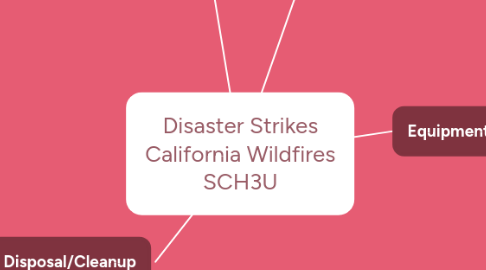Disaster Strikes California Wildfires SCH3U
by KEVIN HUYNH

1. Environmental Effects
1.1. Wildfires emit carbon dioxide and other greenhouse gases that will continue to warm the planet well into the future. They damage forests that would otherwise remove CO2 from the air. And they inject soot and other aerosols into the atmosphere, with complex effects on warming and cooling.
1.1.1. There are a couple of natural causes of a wildfire such as the heat from the sun and lightning, but human causes make up most of the wildfires we get today. Unattended campfires, lit cigarettes, intentional arson and fireworks are common causes of wildfires due to humans.
1.1.1.1. Not much is being done, these wildfires happen every year and continue to have negative impacts on the environment. 68 million tons of CO2 was released from wildfires in 2018.
1.1.1.2. Black carbon, an aerosol thatś released from wildfires, can actually absorb heat while floating around in the air, and that heats the atmosphere. Although this is short lived, scientist have found that the heat trapping potency is much higher than it was before.
2. Disposal/Cleanup
2.1. Separate recyclables, especially materials that can be accepted by a local recycling outlet, such as used motor oil, used tires, waste electronics or waste paint.
2.2. Separate out good wood, including clean, unpainted or preserved demolition lumber, brush, trees and dead fall, etc.
2.3. Take unusable (non hazardous) waste to a landfill, handle dangerous goods as hazardous waste, to ensure theyŕe not disposed in a landfill
3. Units/Measurement
3.1. Heat energy is measured in units of Joules (J), however it can also be measured in Calories (1 Calorie = 4.184 J) and BTU's (1 BTU = 1055 J).
3.2. Scientists are developing the wildland urban interface (WUI) hazard scale, a tool that will help predict the threat and measure the severity of wildfire.
4. Equipment Used
4.1. - Wildland fire gear. - Firefighter Helmets. - Firefighter boots. - Firefighter goggles. - Wildland fire gloves. - Breathing apparatus. - Fireproof blankets.
5. References
5.1. https://www.fs.usda.gov/pnw/page/fire-effects-environment https://www.doi.gov/pressreleases/new-analysis-shows-2018-california-wildfires-emitted-much-carbon-dioxide-entire-years http://www.cafiresci.org/wui-ca https://insideclimatenews.org/news/23082018/extreme-wildfires-climate-change-global-warming-air-pollution-fire-management-black-carbon-co2 https://www.vallfirest.com/en/ https://www.usfa.fema.gov/data/statistics/fire_death_rates.html


